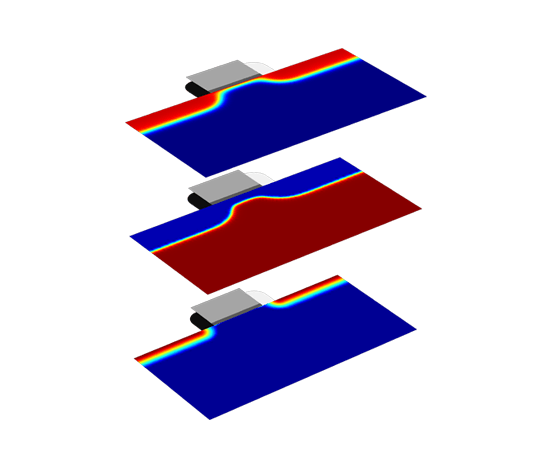COMSOL has the best multiphysical simulation capabilities in my experience. Technical support from Elisa at TECHNIC as well as the engineers at COMSOL has been great.
COMSOL is an important part of our research in plasma physics. We use it in the design of plasma systems and it helps us to obtain a greater understanding of the underlying physics. We have always valued the quick support from TECHNIC and COMSOL and it has been a pleasure to work with them.
Comsol has become a valuable part of our design and decision making process. The exceptional flexibility and access to the physics and solvers in Comsol has allowed us to have deeper understanding on thermomechanical solutions. Technic and Comsol have always been quick and helpful to resolve any issues and provide helpful advice on their products.
At Scion we use COMSOL Multiphysics to understand energy processes, such as the interplay of non-linear solid mechanics and heat & mass transfer during biomass compaction, to design new or more efficient processes.
We use COMSOL Multiphysics to design the customised muffler. With it, we can simulate the insertion loss at different spectrum with different muffler designs.
The Semiconductor Module provides dedicated tools for the analysis of semiconductor device operation at the fundamental physics level. The module is based on the drift-diffusion equations, using isothermal or nonisothermal transport models. It is useful for simulating a range of practical devices, including bipolar transistors, metal-semiconductor field-effect transistors (MESFETs), metal-oxide-semiconductor field-effect transistors (MOSFETs), insulated-gate bipolar transistors (IGBTs), Schottky diodes, and P-N junctions. A predefined Schrödinger Equation interface allows the modelling of quantum-confined systems such as quantum wells, wires, and dots.
Multiphysics effects often play important roles in semiconductor device performance. The Semiconductor Module enables you to easily create models involving multiple physical effects. For example, thermal effects within a power device can be simulated by adding a heat transfer physics interface (available in the COMSOL Multiphysics® software platform). Optical transitions can also be incorporated to simulate a range of devices such as solar cells, light-emitting diodes (LEDs), and photodiodes (some may require the Wave Optics Module).
You can choose to make use of the finite element or finite volume method when modelling the transport of holes and electrons in the Semiconductor Module. Each method has its set of advantages and disadvantages:
Transistor operation where an applied gate voltage turns the device on and then determines the drain saturation current.

The Semiconductor Module is used for modelling semiconductor devices with the conventional drift-diffusion approach, the density-gradient formulation, the Schrodinger equation, or the Schrodinger-Poisson equation. Within the product, there is a number of physics interfaces – tools for receiving model inputs to describe a set of physical equations and boundary conditions. These include interfaces for modelling the transport of electrons and holes in semiconductor devices, the electrostatic behaviour of such, and an interface for coupling semiconductor simulations to a SPICE circuit simulation.
The Semiconductor interface solves Poisson’s equation in conjunction with the continuity equations for the charge carriers. It solves for both the electron and hole concentrations explicitly. You can choose between solving your model with the finite volume method or the finite element method. The Semiconductor interface includes material models for semiconducting and insulating materials, in addition to boundary conditions for ohmic contacts, Schottky contacts, gates, and a wide range of electrostatics boundary conditions.
Features within the Semiconductor interface describe the mobility property as it is limited by the scattering of carriers within the material. The Semiconductor Module includes several predefined mobility models and the option to create custom, user-defined mobility models. Both these types of models can be combined in arbitrary ways. Each mobility model defines an output electron and hole mobility. The output mobility can be used as an input to other mobility models, while equations can be used to combine mobilities, for example using Matthiessen's rule. The Semiconductor interface also contains features to add Auger, Direct, and Shockley-Read Hall recombination to a semiconducting domain, or you can specify your own recombination rate.
Specifying the doping distribution is critical for the modelling of semiconductor devices. The Semiconductor Module provides a Doping model feature to do this. Constant and user-defined doping profiles can be specified, or an approximate Gaussian doping profile can be used. It is also straightforward to import data from external sources into COMSOL Multiphysics®, which can be treated by built-in interpolation functions.
Along with the Semiconductor interface, the Semiconductor Module comes prepared with enhanced Electrostatics capabilities, available both within the Semiconductor interface and in a standalone Electrostatics interface. System level and mixed device simulations are enabled through a physics interface for electrical circuits with SPICE import capability. When combined with the Wave Optics Module or the RF Module, additional physics interfaces are made available for Optoelectronics simulations. The Semiconductor Module includes an additional material database with properties for several materials. Each model comes with documentation that includes a theoretical background and step-by-step instructions on how to create the model. The models are available in COMSOL as MPH-files that you can open for further investigation. You can use the step-by-step instructions and the actual models as a template for your own modelling and applications.
In order to fully evaluate whether or not the COMSOL Multiphysics® software will meet your requirements, you need to contact us. By talking to one of our sales representatives, you will get personalised recommendations and fully documented examples to help you get the most out of your evaluation and guide you to choose the best license option to suit your needs.
Fill in your contact details and any specific comments or questions, and submit. You will receive a response from a sales representative within one business day.